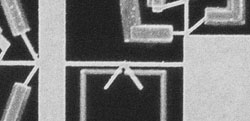Controlling Heat Flow with a Magnet

In a quirky quantum-mechanical connection, a magnetic field can control the flow of heat across a loop of wire. The heat is carried by quantum waves of electrons, and waves traveling around the loop overlap to bolster or limit the flow depending on the strengths of the magnetic field threading the loop, a pair of physicists predicts in the 15 April PRL. Preliminary experiments confirm the prediction. Curiously, even as electrons shuttle heat across the little device, no electrical current flows through it.
For decades, physicists have known that a magnetic field can affect the flow of electricity through a wire that splits and rejoins to form a ring resembling a traffic circle in the middle of a road. Known as the Aharonov-Bohm effect, the phenomenon arises because each electron is described by a quantum wave that splits, so that half of it flows around one side of the ring and half flows around the other side. When the two waves recombine on the far side of the ring they can overlap peak-to-peak to maximize the current, or peak-to-valley to minimize it.
How the waves line up depends on the strength of the magnetic field threading the loop. The field shifts the peaks in the waves going around the two halves of the ring by different amounts. Bizarrely, the field can shift the waves even if it is confined to the hole in the ring and does not extend into the metal through which the electrons flow. Thanks to quantum mechanics, the electrons feel the effect of a field that they never travel through.
But in some ways electrons also behave like particles, so they can convey energy and, hence, heat, as they rattle from the hotter end to the colder end of a wire. And a magnetic field can affect the heat flow through a wire with a loop in much the same way the field can affect the flow of electricity, calculate Zhigang Jiang and Venkat Chandrasekar of Northwestern University in Evanston, Illinois. The researchers analyzed a gizmo known as an Andreev interferometer–essentially a wire a few microns long with a loop of superconducting wire attached to it like a side street that branches from a highway and circles around to merge back into it at the same point. The electrons in the superconductor have wave-like characteristics that are easier to detect than those in ordinary metal.
According to the calculations, the waves of electrons zipping all the way around the superconducting detour cancel or reinforce themselves at the point where they meet the main wire. Such “interference” limits the number of quantum states through which electrons in the ordinary conductor can cross the intersection. That limits the flow of heat, much as a closed lane limits traffic flow on a highway. So as the magnetic field increases, the flow of heat from the hotter to the colder end of the wire climbs and falls repeatedly, just as the electrical current rises and falls in the Aharonov-Bohm effect. However, in this case, no electrical current flows, Chandrasekhar says. “Basically, electrons go from one end to the other, give up their energy, and then go back,” he says, “so there’s no net flow of electric charge.” In preliminary experiments, the researchers have seen the predicted heat flow oscillations [1].
At first glance, the superconducting ring and magnetic field appear to be irrelevant, so the result is surprising, says Dan Prober of Yale University in New Haven, Connecticut. Prober notes that to spot the subtle effect, Chandrasekhar had to bring together several experimental techniques: “He does elegant, hard, and sometimes crazy hard experiments.”
–Adrian Cho
Adrian Cho is a freelance science writer in Grosse Pointe Woods, Michigan.
References
- Z. Jiang and V. Chandrasekhar, “Quantitative measurements of the thermal resistance of Andreev interferometers,” http://www.arxiv.org/abs/cond-mat/0501478.


